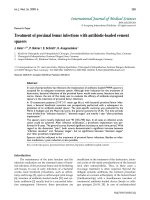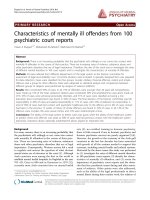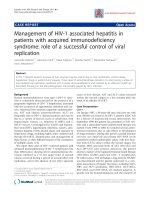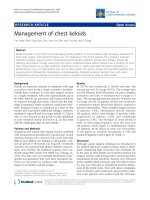Báo cáo y học: "Management of Critically Ill Patients with Severe Acute Respiratory Syndrome (SARS)"
Bạn đang xem bản rút gọn của tài liệu. Xem và tải ngay bản đầy đủ của tài liệu tại đây (102.81 KB, 10 trang )
Int. J. Med. Sci. 2004 1(1): 1-10
1
International Journal of Medical Sciences
ISSN 1449-1907 www.medsci.org 2004 1(1):1-10
©2004 Ivyspring International Publisher. All rights reserved
Management of Critically Ill Patients with Severe Acute
Respiratory Syndrome (SARS)
Review
Received: 2004.2.8
Accepted: 2004.3.05
Published:2004.3.10
Arthur Chun-Wing LAU, Loretta Yin-Chun YAM, Loletta Kit-Ying SO
Division of Respiratory and Critical Care Medicine, Department of Medicine, Pamela
Youde Nethersole Eastern Hospital, Hong Kong SAR, PR China
Abstract
Severe acute respiratory syndrome (SARS) is frequently complicated with
acute respiratory failure. In this article, we aim to focus on the
management of the subgroup of SARS patients who are critically ill. Most
SARS patients would require high flow oxygen supplementation, 20–30%
required intensive care unit (ICU) or high dependency care, and 13–26%
developed acute respiratory distress syndrome (ARDS). In some of these
patients, the clinical course can progress relentlessly to septic shock
and/or multiple organ dysfunction syndrome (MODS). The management
of critically ill SARS patients requires timely institution of
pharmacotherapy where applicable and supportive treatment (oxygen
therapy, noninvasive and invasive ventilation). Superimposed bacterial
and other opportunistic infections are common, especially in those
treated with mechanical ventilation. Subcutaneous emphysema,
pneumothoraces and pneumomediastinum may arise spontaneously or as
a result of positive ventilatory assistance. Older age is a consistently a
poor prognostic factor. Appropriate use of personal protection equipment
and adherence to infection control measures is mandatory for effective
infection control. Much of the knowledge about the clinical aspects of
SARS is based on retrospective observational data and randomized-
controlled trials are required for confirmation. Physicians and scientists
all over the world should collaborate to study this condition which may
potentially threaten human existence.
Key words
SARS, severe acute respiratory syndrome, critically ill patients, management,
treatment and control.
Author
biography
Dr Arthur Lau (MB, MRCP, FHKAM[Medicine]) is Associate Consultant to the
Division of Respiratory and Critical Care Medicine, Department of Medicine, Pamela
Youde Nethersole Eastern Hospital (PYNEH). His research interest is in chronic
obstructive pulmonary disease and clinical cardiopulmonary exercise testing.
Dr Loretta Yam (MB, FRCP, FHKAM[Medicine], FCCP) is Head of the Division of
Respiratory and Critical Care Medicine and Chief of Service of Department of Medicine,
PYNEH. Her research interest is in SARS and asthma.
Dr Loletta So (MB, MRCP, FHKAM[Medicine]) is a specialist in respiratory medicine
at the Division of Respiratory and Critical Care Medicine, Department of Medicine,
PYNEH. Her research interest is in respiratory infections and lung function testing.
Corresponding
address
Dr Arthur LAU, Division of Respiratory and Critical Care Medicine, Department of
Medicine, Pamela Youde Nethersole Eastern Hospital, 3 Lok Man Road, Hong Kong
SAR, PR China; Email: ; Tel: (852)-2595-6111; Fax: (852)-2515-
3182
Int. J. Med. Sci. 2004 1(1): 1-10
2
1. Introduction
In 2003, an outbreak of severe acute respiratory syndrome (SARS) caused by the SARS-associated
coronavirus involved 26 countries and 8098 patients, resulted in 774 deaths [1]. Thereafter, SARS has
re-emerged sporadically in both laboratory and community settings. Its clinical spectrum varies from
minimal respiratory symptoms to severe respiratory failure. We have previously contributed to an
overview on the contemporary treatment of SARS [2], and the whole topic has also been reviewed
elsewhere [3]. In this article, we aim to focus on the management of a subgroup of critically ill SARS
patients with more significant respiratory failure.
2. Clinico-Radiologico-Pathological Features of Critically Ill SARS Patients
Critically ill SARS patients frequently demonstrate the following clinical features: persistent
pyrexia (occasionally from admission but often recurring after an initial period of defervescence),
tachycardia (infrequently bradycardia), tachypnoea and significant oxygen desaturation. More than one-
third of all the SARS patients required high flow oxygen therapy [4], 20–30% required intensive care
unit (ICU) admission or high dependency care, and 13–26% developed acute respiratory distress
syndrome (ARDS) [5,6]. The clinical course of some of these patients can progress relentlessly
irrespective of all attempts at pharmacological treatment, eventually resulting in septic shock and/or
multiple organ dysfunction syndrome (MODS).
Lymphocytopaenia, neutrophilia and thrombocytopenia are frequently seen in critically ill SARS
patients. Neutrophilia could be due to SARS per se, to superimposed infection or related to
corticosteroid administration. Pancytopaenia, if present, could be due to haemophagocytosis syndrome
[7]
or reactivation of latent human parvovirus (unpublished data). Prolonged activated partial
thromboplastin time and picture of disseminated intravascular coagulation has been reported [8]. Co-
infections with other agents including Chlamydia-like agents [9], metapneumovirus [10] or influenza
virus (unpublished data) have been reported. Persistent and increasing elevations of creatine kinase,
lactate dehydrogenase, and transaminases levels are common [11,12,13]. Associated lung damage is
believed to be the result of a virally-triggered inflammatory reaction mediated by a host of cytokines
[14,15]. In sicker patients, levels of pro-inflammatory cytokines (IL-1beta, IL-6, IL-8, IL-16, TNF-α)
and TGF-β1 were higher, with slower decline on clinical recovery [14].
Radiographic abnormalities in the chest usually progress upwards from initial unilateral or bilateral
lower-to mid-zone peripheral ground-glass shadows, to focal, multifocal or diffuse consolidation. Peak
radiographic changes occurred at 8.6 days after fever onset, with 17.4% showing two peaks at 6.3 and
13.5 days, and 4% showing relentless progression [16]. Cavitation is rare but may be associated with
superimposed infection in patients with a prolonged illness course and who are mechanically ventilated
[17]. High-resolution computer tomography (HRCT) of the thorax showed focal ground-glass and
scattered “crazy paving” patterns at presentation, followed by development of interstitial thickening,
consolidation, pleural reaction, and scarring and fibrosis in later stages [18,19]. Small (<1 cm)
pulmonary cysts may be detected even if the patient is not receiving ventilatory assistance [19].
Subcutaneous emphysema, pneumothoraces or pneumomediastinum are distinct complications of
severe SARS [18]. HRCT features of late-stage ARDS caused by SARS are similar to those arising
from other causes [19].
Lung biopsy and postmortem studies [20,21] showed acute-phase diffuse alveolar damage (DAD),
airspace edema, bronchiolar fibrin, increased numbers of interstitial macrophages (with focal
haemophagocytosis) and alveolar macrophages in patients with shorter duration (<10 days) of illness.
On the other hand, histology after >10days of illness showed organizing-phase DAD with increased
fibrosis, hyperplasia of type II pneumocyte, squamous metaplasia, multinucleated giant cells, and acute
bronchopneumonia [20]. In patients who died late in the course of this disease, high loads of viral RNA
were detectable by reverse transcriptase polymerase chain reaction (RT-PCR) in the lungs, bowel,
lymph nodes, spleen, liver, and kidneys [22].
3. Pharmacological Therapy
General principles: Anti-bacterial therapy for community-acquired pneumonia in accordance with
standard guidelines [23] should always be administered before laboratory confirmation of SARS-CoV
infection. Where effective anti-viral therapy is available, it should be started as early as possible after
Int. J. Med. Sci. 2004 1(1): 1-10
3
diagnosis, and even empirically if suspicious clinical features and especially epidemiological links are
present. Since critically ill patients are deemed to have already progressed from the viral replicative
phase to the immunopathological phase [5], concomitant institution of an immunomodulatory therapy
should also be considered [11]. Since there are no consensus regarding the most optimal treatment
regimen in these respects, we will thus review the more commonly used agents and discuss their
relative merits based on published reports. When respiratory failure eventually sets in, oxygen
supplementation, assisted ventilation and intensive supportive treatments will be required.
Antiviral therapy
: Ribavirin was the most commonly used empirical antiviral agent for SARS. It is
a broad-spectrum purine nucleoside analogue which inhibits both RNA and DNA viruses by interfering
with nucleic acid synthesis. There is experimental evidence to show that it has immunomodulatory
effects in the treatment of mouse coronavirus hepatitis [24]. Subsequently, it was found that ribavirin
has no direct in vitro activity against SARS-CoV [25]. Higher doses given intravenously resulted in
more frequent and severe adverse effects including haemolytic anaemia, elevated transaminase levels
and bradycardia [13].
Lopinavir-ritonavir co-formulation (Kaletra
®
, Abbott Laboratories, USA) is a protease inhibitor for
the treatment of human immunodeficiency virus (HIV) infection. It can inhibit the coronaviral
proteases, thus blocking the processing of viral replicase polyprotein and preventing the replication of
viral RNA. Ritonavir inhibits lopinavir metabolism thus increasing its serum concentration, but it has
no activity against SARS-CoV. In a retrospective analysis in Hong Kong [26], 31 patients who had
received Kaletra as rescue therapy together with high dose corticosteroids had no difference in rates of
oxygen desaturation, intubation and mortality compared with a matched cohort. However, when given
as initial treatment in combination with ribavirin in another subgroup of 44 patients, there were
significant reductions in the need for rescue pulsed corticosteroid therapy, intubation rate and overall
mortality. In addition to the prevalence of diarrhoea among these patients which may render oral drugs
more appropriate and useful, synergism between kaletra and ribavirin might have contributed to the
benefits since either drug alone has only weak anti-viral activities. Another Hong Kong study of 41
SARS patients treated with a combination of lopinavir/ritonavir and ribavirin compared with 111
patients (historical controls) treated with ribavirin only showed that adverse clinical outcomes (ARDS
or death) were significantly lower in the treatment group than in the historical controls at day 21 after
symptom onset. Further randomised placebo controlled trials are required [27].
Interferons are a family of cytokines with important roles in the cellular immune response.
Interferon α has been used for SARS treatment in China and Canada [28,29,30]. In an open-label
uncontrolled study [28], nine patients treated with corticosteroids plus interferon alfacon-1 (Infergen
®
,
InterMune Inc., USA) showed better oxygen saturation, faster radiographic resolution and lesser need
for supplemental oxygen compared to 13 given corticosteroids alone. In vitro testing showed that
interferon β was more potent than interferon α or γ, being effective even when administered after
SARS-CoV infection in cell culture [31].
Traditional Chinese herbal medicine has been used concomitantly with other drugs to treat SARS
in mainland China with good results reported [32]. However, its value in critically ill patients has not
been reported. Glycyrrhizin, an active component derived from liquorice roots, is effective against
SARS-CoV in vitro [25]. Its clinical utility remains uncertain. Another herbal compound, Baicalin, also
demonstrates anti-SARS-CoV activity in vitro (unpublished data).
Immunomodulatory therapy
: In the absence of an effective antiviral agent in the 2003 outbreak,
most physicians had opted to use immunomodulatory agents, most commonly corticosteroids, in the
treatment of SARS [11,12,33,34] It is generally agreed that corticosteroids should not be used during
the early viral replicative phase, and that its administration should best coincide with the onset of the
immunopathological phase [5].
Clinico-radiological surrogate criteria have been used to indicate the
onset of this immune hyperactive phase, thus providing a practical guide to the timing of starting
corticosteroids [11]. Corticosteroid dosages should be high enough, especially in the severe cases, to
abort the cytokine storm, and maintained for long enough to prevent the rebound phenomenon
[2,29,35]. This may be achieved by using a weight-adjusted [11] and radiographic extent-modified
dosages [29] for a period of 2–3 weeks.
In one-third to half of SARS patients, fever may recur while on immunomodulatory treatment due
to superimposed infections, too rapid tailing of corticosteroids or persistently severe and uninhibited
cytokine storm. Empirical anti-pseudomonal antibiotics should then be given first. If there is no
Int. J. Med. Sci. 2004 1(1): 1-10
4
apparent clinical response, opportunistic infections like fungal infection should be excluded. If fever is
accompanied by obvious respiratory deterioration in the absence of superimposed pulmonary or
systemic infection, most patients can be presumed to be suffering from a severe recrudescence of the
SARS illness. In such critically ill SARS patients, further escalation of immunomodulation is
warranted. Such deterioration could sometimes occur very rapidly; immediate administration of pulsed
methylprednisolone therapy at 500–1000 mg per day intravenously for 2 days, followed by tapering
doses in the subsequent weeks, has been associated with improved outcome [11,34]. Up to one-third to
one-half of critically ill SARS patients may benefit from this strategy [4,33,34]. Because radiographic
abnormalities may lag behind clinical improvement, persistent radiographic shadows per se, when
accompanied by clinical improvement, do not warrant additional corticosteroids [36].
Human gamma immunoglobulins have been used in selected SARS patients who continued to
deteriorate despite treatment [29,33]. An IgM-enriched immunoglobulin product (Pentaglobin
®
, Biotest
Pharma GmbH, Germany) has been used in Hong Kong and mainland China [29,35,37]. Pentaglobin at
5mg/kg/day for three days given to 12 patients who deteriorated despite repeated rescue
methylprednisolone and ribavirin therapy had shown some improvement in radiographic scores and
oxygen requirement [38]. It has been reported that the use of combined methylprednisolone and high-
dose intravenous immunoglobulin (0.4g/kg) daily for three consecutive days in 15 probable SARS
patients with acute lung injury (ALI) or ARDS had resulted in lower mortality and a trend towards
earlier recovery [39]. Randomized controlled trials in larger numbers of patients are required to confirm
its efficacy.
Based on the assumption that the neutralizing immunoglobulins in convalescent plasma can curb
increases in viral load, convalescent plasma collected from recovered SARS patients has been used in
Hong Kong to treat severely ill patients not responding to corticosteroids. Some clinical benefits were
reportedly observed in a small number of patients [40].
4. Management of SARS-related respiratory failure
Despite all efforts, at least 50% of SARS patients would still develop acute hypoxemic respiratory
failure, with up to 80% requiring supplemental oxygen [37] Overall, 20-30% of patients had been
admitted into ICU, and 10-20% eventually required intubation and mechanical ventilation [4]. Both
non-invasive and invasive ventilatory support has been applied to critically ill SARS patients.
Non-invasive ventilation (NIV)
: NIV delivers continuous positive airway pressure (CPAP) or bi-
level pressure support through a tight-fitting facial or nasal mask. It was commonly employed in many
Chinese hospitals [29,31,37,41,42] and our own centre in Hong Kong [11,43,44]. Early application may
be beneficial because it could rapidly improve vital signs, oxygenation and tachypnoea [41,43], and
may reduce the need for increasing dosages of corticosteroids for progressive respiratory failure. It
could avoid intubation and invasive ventilation in up to two-thirds of critically ill SARS patients
[29,32,43]. Use of NIV in immunocompromised subjects of other diseases has reported similarly
reduced rates of endotracheal intubation and serious complications [45]. NIV in SARS may be of
particular benefit, since high dose corticosteroids per se would already predispose to ventilator-
associated pneumonia, and risks to healthcare workers (HCW) could also be markedly reduced through
obviating the need for intubation, a potentially highly infectious procedure. Patients who respond to
NIV will usually do so within 24 hours, non-responders who will eventually need endotracheal
intubation can thus be identified early [43].
NIV is indicated in the presence of ALI and early ARDS when oxygen saturation (SpO
2
) could not
improve to more than 93% despite >5 litres per minute of oxygen; persistent tachypnoea of at least 30
breaths per minute; and progressive radiographic deterioration in the lungs [43]. The usual
contraindications to NIV apply, including impaired consciousness, uncooperative patient, high
aspiration risk, and haemodynamic instability [35]. SARS-related respiratory failure responds readily to
NIV given at low pressures. CPAP of 4-10 cm H
2
O, or bi-level pressure support with inspiratory
positive airway pressure (IPAP) of <10 cm H
2
O and expiratory positive airway pressure (EPAP) of 4-6
cm H
2
O are reasonable starting pressures [43]. Higher pressures should be avoided whenever possible,
because it may increase the risk of pneumothorax and pneumomediastinum, which are frequently
spontaneous complications of SARS even without assisted positive pressure ventilation [5].
Int. J. Med. Sci. 2004 1(1): 1-10
5
Invasive mechanical ventilation: When patients do not improve within one to two days of NIV or
continue to deteriorate, or if NIV is contraindicated, endotracheal intubation and mechanical ventilation
should be considered. Most centres [64] adopted a ventilatory strategy similar to that recommended for
ARDS from other causes [46]. Both pressure and volume control ventilation may be employed [64].
The tidal volume should be kept low (e.g. 5-6 ml/Kg predicted body weight), and plateau pressures
maintained below 30 cm H
2
O. Because of a higher risk of barotraumas in SARS, the lowest positive
end-expiratory pressure (PEEP) which could achieve satisfactory alveolar recruitment and oxygenation,
usually 5-6 cm water, should be employed. Other adjunctive measures employed in the usual ARDS
cases had been tried in SARS, including: prone positioning [64,47], high frequency oscillatory
ventilation [64,47], nitric oxide [47], high PEEP and regular lung recruitment [64], but their efficacy is
uncertain.
Tracheostomy is required in patients requiring prolonged mechanical ventilation and ICU stay.
Strict adherence to infection control guidelines is mandatory in performing tracheostomy in the ICU or
operating room, as well as during subsequent changes of the tracheostomy tube [48,49].
5. Complications
Critically ill SARS patients on high dose corticosteroids and mechanical ventilation are
particularly susceptible to superimposed bacterial and opportunistic infections. Their peripheral blood
CD3+, CD4+ and CD8+ were also lower than normal [8,24]. Ventilator-associated infection with
organisms like Pseudomonas aeruginosa, methicillin-resistant staphylococcus aureus, Acinetobacter
baumanii, as well as invasive mucor sp [50] and aspergillosis [50,51] have been reported. Strict control
of hyperglycaemia during corticosteroid administration is essential to reduce the chance of septic
complications [52].
Spontaneous subcutaneous emphysema, pneumothoraces and pneumomediastinum are common
complications that are potentially aggravated by noninvasive or invasive ventilation [5]. While chest
drain insertion is useful to relieve pneumothoraces, prolonged air leak may sometimes occur. By itself,
SARS predominantly results in single organ failure of the lungs. Other complications reported are more
likely the result of sepsis and its attending problems, including acute renal failure (6%), acute liver
failure (1%), rhadomyolysis, cardiovascular dysfunction, or of prolonged immobilization and
underlying co-morbidities, including deep vein thrombosis, pulmonary embolism, ischaemic strokes,
etc [53].
6. Outcome and prognosis
The case-fatality ratio (CFR) of SARS has been estimated to range from 0% to >50% depending
on the age group affected. The overall CFR is approximately 15% [54]. Variability may be due to
different host and viral factors as well as treatment strategies. CFR may also be significantly affected by
the duration of follow-up and inclusion of different mixes of suspected, probable and laboratory
confirmed cases in different series [55].
Based on the treatment principles presented above, we have developed a standard treatment
protocol early on in the outbreak, comprising initially high (but not pulsed) dose methylprednisolone
with tapering over three weeks [11]. This protocol was eventually applied to 88 consecutively admitted
SARS patients [56]. Their mean age was 42 years, with 97% having laboratory-confirmed SARS. A
low overall mortality of 3.4% (3/88) was obtained, with all three deaths occurring in patients over the
age of 65 years. Twenty four percent required ICU admission: 14% received NIV (bi-level pressure
support) alone and 10% had both NIV and invasive mechanical ventilation. HRCT thorax in all
survivors taken 50 days after commencement of treatment showed most did not have clinically
significant lung scarring. Another multi-centered study comparing four treatment regimens in
Guangzhou, China, also found that a regimen of high dose corticosteroids adjusted according to clinical
and radiological severity, coupled with nasal CPAP ventilation, produced the best result: zero mortality
in all 60 clinically-defined SARS patients, mean age 30.5 years. With 40% treated with CPAP and
none requiring mechanical ventilation. Subsequently, very low mortality was again recorded among a
further 160 patients treated with the same regimen [29].
Many prognostic factors have been reported to independently predict adverse outcome in SARS.
They include advanced age [4,57,58,59], diabetes [5,13,59], heart disease [5,59], other significant
coexisting conditions [53,59,60], shortness of breath on admission [60], degree of hypoxaemia [58],









